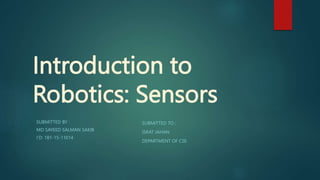
Introduction to the importance of sensors in robotics.pptx
- 1. Introduction to Robotics: Sensors SUBMITTED BY : MD SAYEED SALMAN SAKIB I’D: 181-15-11014 SUBMITTED TO : ISRAT JAHAN DEPARTMENT OF CSE
- 2. Overview Sensors. Specifications of sensors. Attributes of sensors. Type of sensors. Simple Practical Sensors That We can purchase.
- 3. Sensors Definition: A device for sensing a physical variable of a physical system or an environment. Classification of Sensors: • Mechanical quantities: displacement, Strain, rotation velocity, acceleration, pressure, force/torque, twisting, weight, flow • Thermal quantities: temperature, heat. • Electromagnetic/optical quantities: voltage, current, frequency phase; visual/images, light; magnetism. • Chemical quantities: moisture, PH value.
- 4. Specifications of Sensors Accuracy: Error between the result of a Measurement and the true value being measured. Resolution: The smallest increment of measure that a device can make. Sensitivity: The ratio between the change in the output signal to a small change in input physical signal. Slope of the input-output fit line. Repeatability/Precision: The ability of the sensor to Output the same value for the same input over a Number of trials.
- 5. Specifications of Sensors Dynamic Range: the ratio of maximum recordable input amplitude to minimum input amplitude, i.e. D.R. = 20 log (Max. Input Ampl./Min. Input Ampl.) dB Linearity: the deviation of the output from a best-fit straight line for a given range of the sensor Transfer Function (Frequency Response): The relationship between physical input signal and electrical output signal, which may constitute a complete description of the sensor characteristics. Bandwidth: the frequency range between the lower and upper cutoff frequencies, within which the sensor transfer function is constant gain or linear. Noise: random fluctuation in the value of input that causes random fluctuation in the output value
- 6. Attributes of sensors Operating Principle: Embedded technologies that make sensors function, such as electro-optics, electromagnetic, piezoelectricity, active and passive ultraviolet. Dimension of Variables: The number of dimensions of physical variables. • Size: The physical volume of sensors. Data Format: The measuring feature of data in time; continuous or discrete/analog or digital. Intelligence: Capabilities of on-board data processing and decision- making. Active versus Passive Sensors: Capability of generating vs. just receiving signals. Physical Contact: The way sensors observe the disturbance in environment. Environmental durability: will the sensor robust enough for its operation Conditions.
- 7. Type of sensors Active – send signal into environment and measure interaction of signal w/ environment – e.g. radar, sonar. Passive – record signals already present in environment – e.g. video cameras.
- 8. Type of sensors Classification by medium used – based on electromagnetic radiation of various wavelengths. – vibrations in a medium. – concentration of chemicals in environment. – by physical contact.
- 9. Type of sensors Exteroceptive: deal w/ external world – where is something ? – how does is look ? (camera, laser rangefinder). Proprioceptive: deal w/ self – where are my hands ? (encoders, stretch receptors) – am I balanced ? (gyroscopes, INS)
- 10. Type of sensors Interoceptive – what is my thirst level ? (biochemical) – what is my battery charge ? (voltmeter) • For the most part we’ll ignore these in this Class.
- 11. Simple Practical Sensors That We can purchase O Touch sensors o Tilt sensors o Encoders o Bend sensors o Light sensors o Temperature sensors o Potentiometers o Laser rangefinders o Cameras
- 12. Thank You